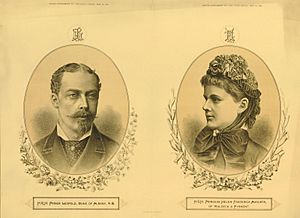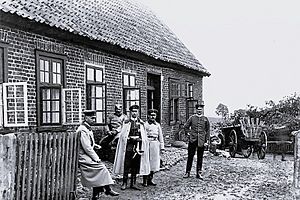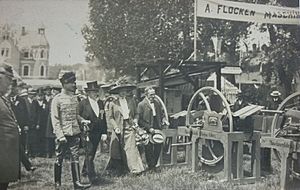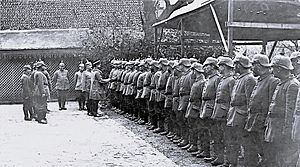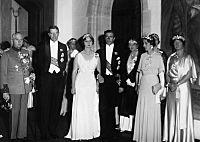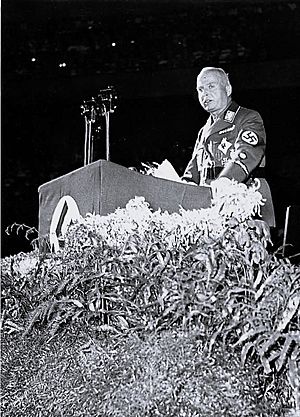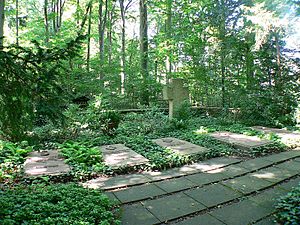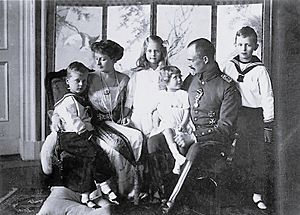Charles Edward, Duke of Saxe-Coburg and Gotha facts for kids
Quick facts for kids Charles Edward |
|||||
|---|---|---|---|---|---|
| Duke of Albany | |||||
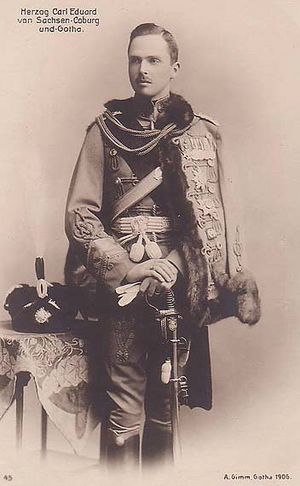
The Duke c. 1905
|
|||||
| Duke of Saxe-Coburg and Gotha | |||||
| Reign | 30 July 1900 – 14 November 1918 | ||||
| Predecessor | Alfred | ||||
| Successor | Monarchy abolished | ||||
| Regent | Ernst, Hereditary Prince of Hohenlohe-Langenburg (1900–1905) | ||||
| Born | Prince Charles Edward, Duke of Albany 19 July 1884 Claremont House, Surrey, England |
||||
| Died | 6 March 1954 (aged 69) Coburg, West Germany (now Germany) |
||||
| Burial | near Schloss Callenberg, Germany | ||||
| Spouse |
Princess Victoria Adelaide of Schleswig-Holstein
(m. 1905) |
||||
| Issue |
|
||||
|
|||||
| House | Saxe-Coburg and Gotha | ||||
| Father | Prince Leopold, Duke of Albany | ||||
| Mother | Princess Helen of Waldeck and Pyrmont | ||||
| Military career | |||||
| Allegiance |
|
||||
| Service/ |
|||||
| Years of service | 1904–1918, 1933–1945 | ||||
| Rank |
|
||||
| Unit | 1st Foot Guards Sturmabteilung National Socialist Flyers Corps |
||||
| Battles/wars |
|
||||
Charles Edward (Leopold Charles Edward George Albert, German: Leopold Carl Eduard Georg Albert; 19 July 1884 – 6 March 1954) was the last sovereign duke of Saxe-Coburg and Gotha, from 30 July 1900 until 1918. A male-line grandson of Queen Victoria and Prince Albert, he was also until 1919 a Prince of the United Kingdom and from birth held the British titles of Duke of Albany, Earl of Clarence and Baron Arklow.
Charles Edward spent his childhood years in the United Kingdom but was sent to Germany in his mid-teens, and received the final years of his education there, after in 1900 unexpectedly inheriting the throne of the Duchy of Saxe-Coburg and Gotha in the German Empire, due to the early deaths of his cousin Alfred, Hereditary Prince of Saxe-Coburg and Gotha, and his uncle Duke Alfred. He took full responsibility for the role in 1905. His style of governance was considered to be loyal to the emperor and somewhat autocratic. He also supported art, science and local industry.
During the First World War, Charles Edward's support for his adoptive country led to him being viewed with increased hostility in Britain and ultimately losing his British titles, while in Germany, the end of the Empire led to the loss of his constitutional position. After this, he drifted towards far-right politics, and later became involved in the Nazi regime. After the Second World War, he was fined by a Denazification court and lost ownership of land in the Soviet occupation zone of Germany (later East Germany). Charles Edward died in poverty in Coburg, which by then was part of Bavaria in West Germany, in 1954.
Contents
Early life in Britain
Prince Charles Edward was born at Claremont House near Esher, Surrey. His father was Prince Leopold, Duke of Albany, the eighth child of Queen Victoria and Prince Albert. His mother was Princess Helen of Waldeck and Pyrmont, the fourth daughter of George Victor of Waldeck and Pyrmont and of his first wife Princess Helena of Nassau. Prince Leopold had suffered from hemophilia but a boy cannot inherit the condition from his father so Charles Edward was healthy. As Leopold had died before Charles Edward's birth, Prince Charles Edward succeeded to his titles at birth and was styled His Royal Highness the Duke of Albany. After falling ill, the young royal duke was baptised privately at Claremont on 4 August 1884. He was publicly baptised in Esher Parish Church on 4 December 1884.
Charles Edward was brought up as a Prince of the United Kingdom for his first 15 years. He was seen as a sickly, timid and spoilt child. Charles Edward had one sister, Alice, who had been born a year before him. Princess Helen and the children lived with members of the wider royal family in close proximity to Queen Victoria. As a child, Charles Edward attended two prep schools. First Sandroyd School in Surrey and later Park Hill School in Lyndhurst. In 1898 he enrolled at Eton College and his mother hoped he would eventually go onto Oxford University. He was happy at Eton and looked back nostalgically at his time at that school throughout his life.
Duke of Saxe-Coburg and Gotha
Accession and education in Germany
In 1899, the House of Saxe-Coburg and Gotha, influenced by Emperor Wilhelm II of Germany, decided on how to deal with the succession of Duke Alfred, who was in ill health. His only son, Prince Alfred ("Young Affie"), had died in February 1899. Prince Arthur, Duke of Connaught and Strathearn, the Queen's third son, was serving in the British army, causing Wilhelm II to oppose him as a ruling prince of Germany. His son, Prince Arthur of Connaught, had been at Eton with Charles Edward. Wilhelm II demanded a German education for the boy, but this was unacceptable to the Duke of Connaught. Thus young Arthur also renounced his claims to the Duchy leaving Charles Edward next in line. He was named heir under family pressure. There were reports in the American press that the younger Arthur had beaten Charles Edward up or threatened to do so if he did not except the position.
With his mother and sister, Charles Edward moved to Germany when he was fifteen, although he spoke little German. Duke Alfred wanted to separate the boy from his mother so she took him to stay with her brother-in-law Wilhelm of Württemberg and found him a tutor. Charles Edward inherited the ducal throne of Saxe-Coburg and Gotha at the age of sixteen when his uncle Alfred died at the age of 55 in July 1900. Emperor Wilhelm organised an education plan for Charles Edward. Inviting the family to live in Potsdam, the government district of Berlin, while Charles Edward attended the Preußische Hauptkadettenanstalt (Prussian Central Cadet Institute) at Lichterfelde. He also attended Bonn University. Became a member of Corps Borussia Bonn and joined the 1st Garderegiment zu Fuß at Potsdam. His uncle, King Edward VII, made him a Knight of the Garter on 15 July 1902, just prior to his 18th birthday. His entry in the Oxford Dictionary of National Biography describes him as a "conscientious young man with a taste for the arts and music" who became popular in Coburg during this period. According to a contemporary news report he was fond of "sport and adventure". Wilhelm II, his older cousin, took a great deal of interest in Charles Edward assimilation into German society. To the extent that he was known as "the Emperor's seventh son" in the German Imperial Court. Charles Edward, his mother and sister spent a lot of their spare time in the German court in Berlin where they treated as members of the emperors family. The women got on well with the German Empress, while, Wilhelm became something of a substitute father for Charles Edward. Wilhelm saw Charles Edward as impressionable and introduced him to his own worldview including Anti-Semitism and German Nationalism. During a political scandal in 1908 there were allegations of Charles Edward engaging in homosexual activity with Wilhelm. Charles Edward often didn't enjoy his time in Berlin where the emperor seemed to become resentful of him and frequently bullied him. A 1905 report by the court chaplin commented that Wilhelm had given the young man a "proper beating up" one evening.
Reign
From 1900 to 1905, Charles Edward reigned through the regency of Ernst, Hereditary Prince of Hohenlohe-Langenburg, the husband of Duke Alfred's third daughter Alexandra. The regent acted under the strict guidance of Emperor Wilhelm II. Upon coming of age on 19 July 1905, Charles Edward assumed full constitutional powers. He proved loyal to the Emperor and was deemed a constitutionally-minded prince. However, he soon deviated from his early liberal views and gave in to autocratic impulses, also becoming dependent on advisers at his two courts at Gotha and Coburg, between which political differences and rivalries had developed. He liberally supported the court theatres in both towns. Taking an interest in Zeppelin and aeroplane technology, Charles Edward supported the newly created aircraft industry at Gotha (see Gothaer Waggonfabrik). Like all Dukes of Saxe-Coburg and Gotha, he divided his time between the two towns. Among his Schloss Friedenstein, Ehrenburg Palace, and Schloss Callenberg residences, he favoured the last. He also took great interest in the renovation of Veste Coburg, which had been abandoned as a ducal residence in the 17th century. This work, which strained the ducal finances, lasted from 1908 until 1924.
The Duke was not without sympathy for his native United Kingdom, visiting often and remaining on good terms with the British royal family. World War I caused a conflict of loyalties for Charles Edward, but he finally decided to support the German Empire. On holiday in England when the war started, he told his sister that he wanted to fight for Great Britain but felt obligated to return to his duchies where public opinion was turning against the Duke due to his English origins. He broke off relations with his family at the British and Belgian courts; this did not suffice to overcome doubts about his loyalties in Germany. Incapable of active combat due to a lame leg, Charles Edward served on the staff of an infantry division of the German army at the beginning of the war, fighting Russians in East Prussia. In 1915, he had to stop due to rheumatism. Although he never held a command, he visited both the western and eastern fronts numerous times. Soldiers from his duchies were awarded the Carl-Eduard-Kriegskreuz. He was supportive of soldiers from those territories and his attitudes would become in general more sincerely pro-German as the war years progressed. In 1917, a law change in Coburg effectively banned Charles Edward's British relatives from succeeding him and that same year the Gotha G.V bomber which had been built in Gotha was used to attack London. In Britain, he was denounced as a traitor. In 1915, King George V, his cousin, ordered his name removed from the register of the Most Noble Order of the Garter. The Titles Deprivation Act 1917 began the process of removing his British titles. German historian Hubertus Büschel argues that Charles Edward's World War 1 experiences were a "school for nationalism, violence, and antisemitism".
Weimar Republic
On the morning of 9 November 1918, during the German Revolution, the Workers' and Soldiers' Council of Gotha declared him deposed. On 11 November, his abdication was demanded in Coburg. Only on 14 November, later than most other ruling princes, did he formally announce that he had "ceased to rule" in both Gotha and Coburg. He did not explicitly renounce his throne. The following year, he also lost his British titles, though some personal sympathy remained for him among the political establishment in the United Kingdom, due to the way German nationality had been forced on him as a teenager.
In 1919, his properties and collections in Coburg were transferred to the Coburger Landesstiftung, a foundation that still exists today. A similar solution for Gotha took longer, and only after legal struggles with the Free State of Thuringia was it set up in 1928–34. The Gotha foundation was expropriated by the Soviet authorities after 1945. After 1919, the family retained Schloss Callenberg, some other properties (including those in Austria), and a right to live at Veste Coburg. It also received substantial financial compensation for lost possessions. Some additional real estate in Thuringia was restored to the ducal family in 1925.
Politically, in the post WW1 period, Charles Edward aimed for the restoration of the monarchy and supported the nationalistic-conservative, völkisch right. Now a private citizen, Charles Edward became associated with various right-wing paramilitary and political organisations. These organisations were associated with violent repression, anti-government activities and politically motivated murders. He supported Hermann Ehrhardt, both morally and financially, after the Freikorps' commander's participation in the failed Kapp Putsch. It was rumoured that Charles Edward wanted to return to political power as "King of Thuringia". Charles Edward met Adolf Hitler for the first time on 14 October 1922, at the Nazis' second Deutscher Tag held at Coburg. In 1923, he joined the Bund Wiking as Oberbereichsleiter in Thuringia. When the Wiking joined Der Stahlhelm, Charles Edward became a member of the Stahlhelm's national board. From 1929, he provided financial support to the Nazi Party. He was attracted by the party's militarism and anti-communism.
Charles Edward was a useful ally for the Nazis in the period before they gained power with extensive links in Franconia and across Germany. In 1932, Charles Edward took part in the creation of the Harzburg Front, through which the German National People's Party and other groups with similar views became associated with the Nazi Party. He also publicly called on voters to support Hitler in the presidential election of 1932. A few months later, Charles Edward's daughter Sibylla married Prince Gustaf Adolf, Duke of Västerbotten, the eldest son of the Crown Prince of Sweden and second-in-line to the Swedish throne. The marriage meant that Sibylla would, in the normal course, become Queen of Sweden. He used the event as a public display of his ideology and to improve the damaged prestige of the house of Saxe-Coburg-Gotha.
Nazi Germany
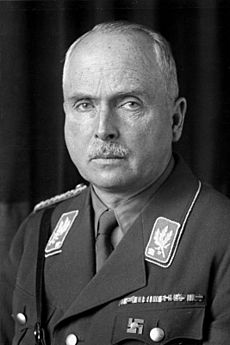
Charles Edward formally joined the Nazi Party in March 1933, he also became a Obergruppenführer in the SA. Charles Edward was made president of the National Socialist Automobile Association, an organisation which provided vehicles for the German state including those used to carry out the Holocaust. From 1936 to 1945, he served as a member of the Reichstag, representing the Nazi Party, and was president of the German Red Cross from December 1933 to 1945. By the time he took over the position, the German Red Cross had already been placed under the Nazis' control. Under Charles Edward's leadership, the German Red Cross reduced its interest in improving the welfare of the civilian population in order to focus on military matters and introduced various displays of allegiance towards the regime. His deputy Ernst-Robert Grawitz was involved in human experimentation in the concentration camps.

The regime made significant use of Charles Edward as an informal diplomat. In 1934, Charles Edward visited Japan, where he attended a conference on the protection of civilians during war, and delivered Hitler's birthday greeting to Emperor Hirohito. In 1940, Charles Edward travelled via Moscow and Japan to the US, where he met President Roosevelt at the White House. In 1943, at Hitler's behest, Charles Edward asked the International Red Cross to investigate the Katyn massacre. He was particularly significant to their attempts to cultivate pro-German sentiments among the British aristocracy. By 1936, he had agreed to be a spy for Hitler while attending the funeral of his first cousin George V at Sandringham, He attended George V's funeral as Hitler's representative, in an SA uniform, complete with metal helmet. He was president of the Anglo-German fellowship and lobbied figures believed to be pro-German.
His Oxford Dictionary of National Biography entry argues that Charles Edward's advocacy had little success, and that he failed to understand the degree to which the people he had grown up around now saw him as a foreigner. In contrast, German historian Karina Urbach argued in her 2015 book that the strains British society experienced in the post World War 1 period had a radicalising effect on sections of the British elite and that there was significant sympathy for Fascism albeit discomfort with Nazism in particular among the aristocracy. She wrote that Charles Edward reintegrated himself into aristocratic social life in Britain with the help of his sister and influenced prominent figures such as the Prince of Wales.

Urbach also said she found evidence of Charles Edward donating generously to the Nazi party for years, financing political murders and being aware of the death camps in Buchenwald. In 1945, the Führer ordered that he not be allowed to be captured because of the great deal of inside information that he possessed. According to a review of a documentary about his life in The Guardian, he was aware of the death camps' work, and the programme that killed more than 100,000 disabled people in Germany, Austria, and other German-occupied territories from 1940 onwards. Although Charles Edward was too old for active service during World War II, his three sons served in the Wehrmacht. His son and son-in-law were killed in action. His support for Nazism grew more intense during the war years and never relented.
Postwar period and death
After the end of World War II, Charles Edward was interned by the American military authorities from 1945 to 1946. His sister lobbied unsuccessfully for his release on health grounds. In 1950 (or August 1949, according to his Oxford Dictionary of National Biography entry) Charles Edward was found by a denazification court to be a Mitläufer and Minderbelasteter (roughly translated as: follower and follower of lesser guilt). Charles Edward also lost significant property as a result of his participation in World War II. Gotha was part of Thuringia, and therefore situated in the Soviet occupation zone. The Soviet Army confiscated much of the family's property in Gotha. However, Coburg had become part of Bavaria in 1920 and was occupied by American forces. As such the family was able to retain property in what would become West Germany.
In April 1946, his daughter Sibylla gave birth to a son, the future Carl XVI Gustaf of Sweden, who became, upon birth, third in the line of succession to the Swedish throne. In January 1947, Sybilla's husband died in a plane crash, and in October 1950, Gustaf V of Sweden died, at which point Charles Edward's grandson became the Crown Prince of Sweden, who later became King Carl Gustaf.
Charles Edward spent the last years of his life in seclusion, forced into poverty by the fines he had been required to pay by the denazification tribunal, and the seizure of much of his property by the Soviets. In 1953, he viewed the coronation of his cousin's granddaughter, Elizabeth II, in a local cinema. According to a column published that year in The Scotsman Charles Edward had reestablished links with the Seaforth Highlanders a British Army regiment which he had once been Colonel-in-chief of.
Charles Edward died of cancer in his flat in Elsässer Straße, Coburg, on 6 March 1954, at the age of 69, his obituary in The Times commented that "...he was Hitler's man... Whether, and to what extent, he was admitted to the inner council of the Nazi gang is as yet an open question." He was the penultimate ruling prince of the German Empire to die; only Ernst II of Saxe-Altenburg outlived him – see List of German monarchs in 1918. He is buried at the Waldfriedhof Cemetery (Waldfriedhof Beiersdorf) near Schloss Callenberg, in Beiersdorf near Coburg.
Marriage and family
Wilhelm II chose Princess Victoria Adelaide of Schleswig-Holstein, the niece of his wife, Empress Augusta Victoria, as the bride of Charles Edward. They married on 11 October 1905, at Glücksburg Castle, Schleswig-Holstein, and had five children. Victoria Adelaide was described in her grandson's memoirs as the leading part in the marriage and the Duke would initially come to her for advice.
The family mainly spoke English at home, though the children learnt to speak German fluently. Hubertus, Charles Edward's second son, was the favourite child. A profile of the family published in a British newspaper The Sphere shortly before the outbreak of WWI described Charles Edward's sons and daughters as "bright, happy children who lead a natural life, spending a great deal of their time in the open air in the fine grounds of their castle" and mentioned they enjoyed various sports. Later, according to German historian Karina Urbach, the children lived in fear of their father, who ran his family "like a military unit". ..... The allegation was backed by one of her brothers. When they grew up, Charles Edward's children were often a disappointment to him in their choice of romantic relationships at a time when he was trying to use strategic marriages to improve the diminished reputation of his royal house.
Issue
| Name | Birth | Death | Marriages |
|---|---|---|---|
| Johann Leopold, Hereditary Prince of Saxe-Coburg and Gotha | 2 August 1906 |
4 May 1972 |
(1) unequally, renouncing his rights to the headship of the House of Saxe-Coburg and Gotha, 9 March 1932, Baroness Feodora von der Horst; divorced 1962; had issue (2), 5 May 1963, Maria Theresia Reindl; no issue |
| Princess Sibylla of Saxe-Coburg and Gotha | 18 January 1908 |
28 November 1972 |
20 October 1932, Prince Gustaf Adolf of Sweden, Duke of Västerbotten, and had issue, including Carl XVI Gustaf of Sweden |
| Prince Hubertus of Saxe-Coburg and Gotha | 24 August 1909 |
26 November 1943 |
killed near Mosty, no children |
| Princess Caroline Mathilde of Saxe-Coburg and Gotha | 22 June 1912 |
5 September 1983 |
married Friedrich Wolfgang Otto, Count of Castell-Rüdenhausen (27 June 1906 – 11 June 1940) on 14 December 1931, divorced on 2 May 1938, and had issue.
She married Flight Captain Max Schnirring (20 May 1895 – 7 July 1944) on 22 June 1938, and had issue. She married Karl Otto Andree (10 February 1912 – 1984) on 23 December 1946 and divorced on 10 October 1949 |
| Friedrich Josias, Prince of Saxe-Coburg and Gotha | 29 November 1918 |
23 January 1998 |
(1), 25 January 1942, Countess Viktoria-Luise of Solms-Baruth; divorced 19 September 1947; had issue (2), 14 February 1948, Denyse Henrietta von Muralt; divorced 17 September 1964; had issue (3), 30 October 1964, Katrin Bremme; no issue |
Orders and decorations


 Ernestine duchies:
Ernestine duchies:
- Joint Grand Master of the Saxe-Ernestine House Order, 30 July 1900
- Founder of the Carl Eduard War Cross, 19 July 1916
 United Kingdom:
United Kingdom:
- GCVO: Honorary Grand Cross of the Royal Victorian Order, 27 January 1901 (Expelled in 1915)
- KG: Royal Knight of the Garter, 15 July 1902 (Expelled in 1915)
 Württemberg: Grand Cross of the Württemberg Crown, 1902
Württemberg: Grand Cross of the Württemberg Crown, 1902 Baden: Knight of the House Order of Fidelity, 1904
Baden: Knight of the House Order of Fidelity, 1904 Belgium: Grand Cordon of the Order of Leopold, 1905 – wedding gift of King Leopold II
Belgium: Grand Cordon of the Order of Leopold, 1905 – wedding gift of King Leopold II Denmark: Knight of the Elephant, 16 June 1906
Denmark: Knight of the Elephant, 16 June 1906
 Austria-Hungary: Grand Cross of the Royal Hungarian Order of St. Stephen, 1906
Austria-Hungary: Grand Cross of the Royal Hungarian Order of St. Stephen, 1906 Kingdom of Bavaria: Knight of St. Hubert, 1907
Kingdom of Bavaria: Knight of St. Hubert, 1907 Kingdom of Bulgaria:
Kingdom of Bulgaria:
- Knight of Saints Cyril and Methodius, with Collar
- Order of Bravery, Grade III Class I
 Norway: Grand Cross of St. Olav, 20 October 1932
Norway: Grand Cross of St. Olav, 20 October 1932 Kingdom of Prussia:
Kingdom of Prussia:
- Knight of the Black Eagle
- Grand Cross of the Red Eagle
- Pour le Mérite (military)
- Knight of Honour of the Johanniter Order
 Kingdom of Saxony: Knight of the Rue Crown
Kingdom of Saxony: Knight of the Rue Crown Sweden: Knight of the Seraphim, 20 October 1932
Sweden: Knight of the Seraphim, 20 October 1932 Nazi Germany: NSDAP Long Service Award, 3rd Class (10 years)
Nazi Germany: NSDAP Long Service Award, 3rd Class (10 years)
Legacy
In December 2007, Britain's Channel 4 aired an hour-length documentary about Charles Edward called Hitler's Favourite Royal. A review in The Guardian described the film as a "A solid documentary on a feeble man and a wretched family." Another review in The Telegraph suggested the documentary had been overly sympathetic to Charles Edward stating that the "story emerged as a tale of pure tragedy. Which it undoubtedly was, in parts," but that he was depicted "As if the trauma of being elevated to a dukedom and losing it had somehow robbed him of his ability to tell right from wrong."
Karina Urbach's 2015 book Go Betweens for Hitler discusses how various aristocrats including Charles Edward acted as informal diplomats for Nazi Germany. A review in The Times commented on Charles Edward that "For many years thereafter [the German Revolution], Carl Eduard was regarded as a mere footnote in history; a harmless, potty old aristocrat, washed up by the seismic upheavals of the early 20th century. However, that benign interpretation has been recently revised. We now know that Carl Eduard was a member of the Nazi party, a sponsor of paramilitary terrorism and — as Karina Urbach’s excellent book demonstrates — an important “go-between” for Hitler."
Ancestry
| Ancestors of Charles Edward, Duke of Saxe-Coburg and Gotha | |||||||||||||||||||||||||||||||||||||||||||||||||||||||||||||||||||||||||||||||||||||||||||||||||||||||||||||||||||||||||||||||||||||||||||||||||||||||||||||||||||||||||||||||||||||||||||||||||||||||||||||||||||||||||||||||||||||||||||||||||||||||||||||||||||||||||||||||||||||||||
|---|---|---|---|---|---|---|---|---|---|---|---|---|---|---|---|---|---|---|---|---|---|---|---|---|---|---|---|---|---|---|---|---|---|---|---|---|---|---|---|---|---|---|---|---|---|---|---|---|---|---|---|---|---|---|---|---|---|---|---|---|---|---|---|---|---|---|---|---|---|---|---|---|---|---|---|---|---|---|---|---|---|---|---|---|---|---|---|---|---|---|---|---|---|---|---|---|---|---|---|---|---|---|---|---|---|---|---|---|---|---|---|---|---|---|---|---|---|---|---|---|---|---|---|---|---|---|---|---|---|---|---|---|---|---|---|---|---|---|---|---|---|---|---|---|---|---|---|---|---|---|---|---|---|---|---|---|---|---|---|---|---|---|---|---|---|---|---|---|---|---|---|---|---|---|---|---|---|---|---|---|---|---|---|---|---|---|---|---|---|---|---|---|---|---|---|---|---|---|---|---|---|---|---|---|---|---|---|---|---|---|---|---|---|---|---|---|---|---|---|---|---|---|---|---|---|---|---|---|---|---|---|---|---|---|---|---|---|---|---|---|---|---|---|---|---|---|---|---|---|---|---|---|---|---|---|---|---|---|---|---|---|---|---|---|---|---|---|---|---|---|---|---|---|---|---|---|---|---|---|---|---|
|
|||||||||||||||||||||||||||||||||||||||||||||||||||||||||||||||||||||||||||||||||||||||||||||||||||||||||||||||||||||||||||||||||||||||||||||||||||||||||||||||||||||||||||||||||||||||||||||||||||||||||||||||||||||||||||||||||||||||||||||||||||||||||||||||||||||||||||||||||||||||||


